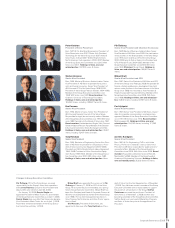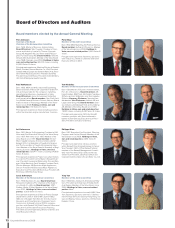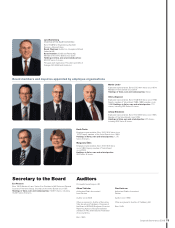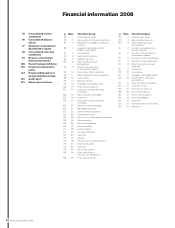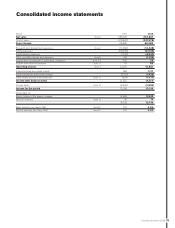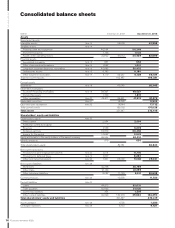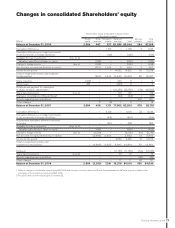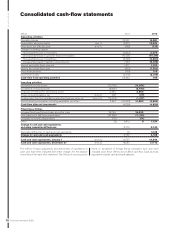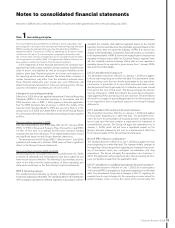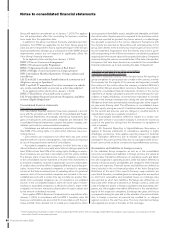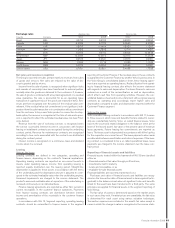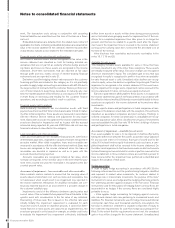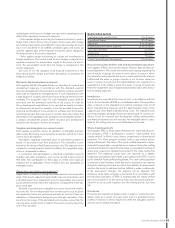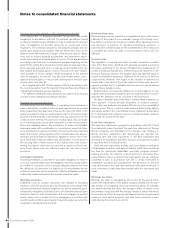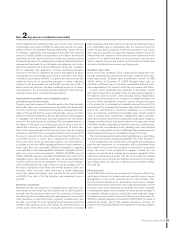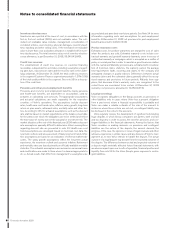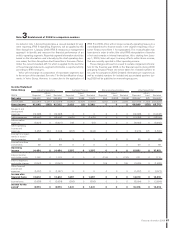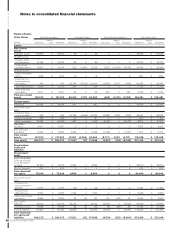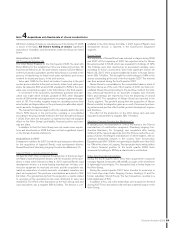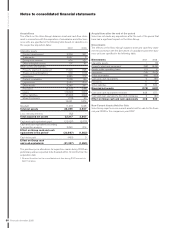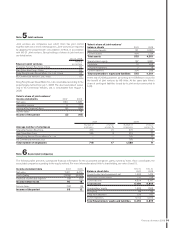Volvo 2008 Annual Report Download - page 85
Download and view the complete annual report
Please find page 85 of the 2008 Volvo annual report below. You can navigate through the pages in the report by either clicking on the pages listed below, or by using the keyword search tool below to find specific information within the annual report.
81
Financial information 2008
Net sales and revenue recognition
The Group’s reported net sales pertain mainly to revenues from sales
of goods and services. Net sales are reduced by the value of dis-
counts granted and by returns.
Income from the sale of goods is recognized when signifi cant risks
and rewards of ownership have been transferred to external parties,
normally when the goods are delivered to the customers. If, however,
the sale of goods is combined with a buy-back agreement or a residual
value guarantee, the sale is accounted for as an operating lease
transaction if signifi cant risks of the goods are retained in Volvo. Rev-
enues are then recognized over the period of the residual value com-
mitment. If the residual value risk commitment is not signifi cant, inde-
pendent from the sale transaction or in combination with a commitment
from the customer to buy a new Volvo product in connection to a buy-
back option, the revenue is recognized at the time of sale and a provi-
sion is reported to refl ect the estimated residual value risk (see Provi-
sions below).
Revenue from the sale of workshop services is recognized when
the service is provided. Interest income in conjunction with fi nance
leasing or installment contracts are recognized during the underlying
contract period. Revenue for maintenance contracts are recognized
according to how costs associated with the contracts are distributed
during the contract period.
Interest income is recognized on a continuous basis and dividend
income when it is received.
Leasing
Volvo as the lessor
Leasing contracts are defi ned in two categories, operating and
fi nance leases, depending on the contract’s fi nancial implications.
Operating leasing contracts are reported as non-current assets in
Assets under operating leases. Income from operating leasing is
reported equally distributed over the leasing period. Straight-line
depreciation is applied to these assets in accordance with the terms
of the undertaking and the deprecation amount is adjusted to corre-
spond to the estimated realizable value when the undertaking expires.
Assessed impairments are charged to the income statement. The
product’s assessed realizable value at expiration of the undertaking is
reviewed continuously on an individual basis.
Finance leasing agreements are reported as either Non-current or
current receivables in the customer fi nance operations. Payments
from fi nance leasing contracts are distributed between interest
income and amortization of the receivable in the customer fi nance
operations.
In accordance with IAS 14, Segment reporting, operating leasing
contracts should be reclassifi ed to fi nance leases in the segment
reporting of Customer Finance if the residual value in these contracts
is guaranteed to Customer Finance by another Volvo business area. In
the Volvo Group’s consolidated balance sheet, these leasing agree-
ments are reported as operating leases. Reclassifi cation from operat-
ing to fi nancial leasing contract also affects the income statement
with regards to sales and depreciation. Customer Finance’s sales are
reduced as a result of the reclassifi cation as well as depreciation,
which affect cash fl ow from operating activities. However, the con-
solidated balance sheet and income statement still recognize leasing
contracts as operating and, accordingly, report higher sales and
depreciation compared to sales and depreciation reported within the
Customer Finance segment.
Volvo as the lessee
Volvo evaluates leasing contracts in accordance with IAS 17, Leases.
In those cases in which risks and benefi ts that are related to owner-
ship are substantially held by Volvo, so called fi nance leases, Volvo
reports the asset and related obligation in the balance sheet at the
lower of the leased asset’s fair value or the present value of minimum
lease payments. Future leasing fee commitments are reported as
loans. The lease asset is depreciated in accordance with Volvo’s policy
for the respective non-current asset. The lease payments when made
are allocated between amortization and interest expenses. If the leas-
ing contract is considered to be a so called operational lease, lease
payments are charged to the income statement over the lease con-
tract period.
Reporting of fi nancial assets and liabilities
Financial assets treated within the framework of IAS 39 are classifi ed
either as
– Financial assets at fair value through profi t and loss,
– Investments held to maturity,
– Loans and receivables, or as
– Available-for-sale fi nancial assets
Financial liabilities are reported at amortized cost.
Purchases and sales of fi nancial assets and liabilities are recog-
nized on the transaction date. A fi nancial asset is derecognized (extin-
guished) in the balance sheet when all signifi cant risks and benefi ts
linked to the asset have been transferred to a third party. The same
principles are applied for fi nancial assets in the segment reporting of
Volvo Group.
The fair value of assets is determined based on the market prices
in such cases they exist. If market prices are unavailable, the fair value
is determined for each asset using various valuation techniques.
Transaction expenses are included in the asset’s fair value except in
cases in which the change in value is recognized in the income state-
Exchange rates Average rate Closing rate
Country Currency 2007 2008 2007 2008
Brazil BRL 3.4724 3.6152 3.6800 3.2490
Canada CAD 6.3098 6.1723 6.5960 6.3060
China CNY 0.8876 0.9464 0.8900 1.1300
Denmark DKK 1.2423 1.2895 1.2716 1.4691
Euro EUR 9.2564 9.6142 9.4828 10.9448
Great Britain GBP 13.5369 12.0975 12.9113 11.2538
Japan JPY 0.0575 0.0641 0.0573 0.0861
Norway NOK 1.1555 1.1716 1.1885 1.1045
South Korea KRW 0.0073 0.0060 0.0069 0.0061
United States USD 6.7631 6.5821 6.4688 7.7538


